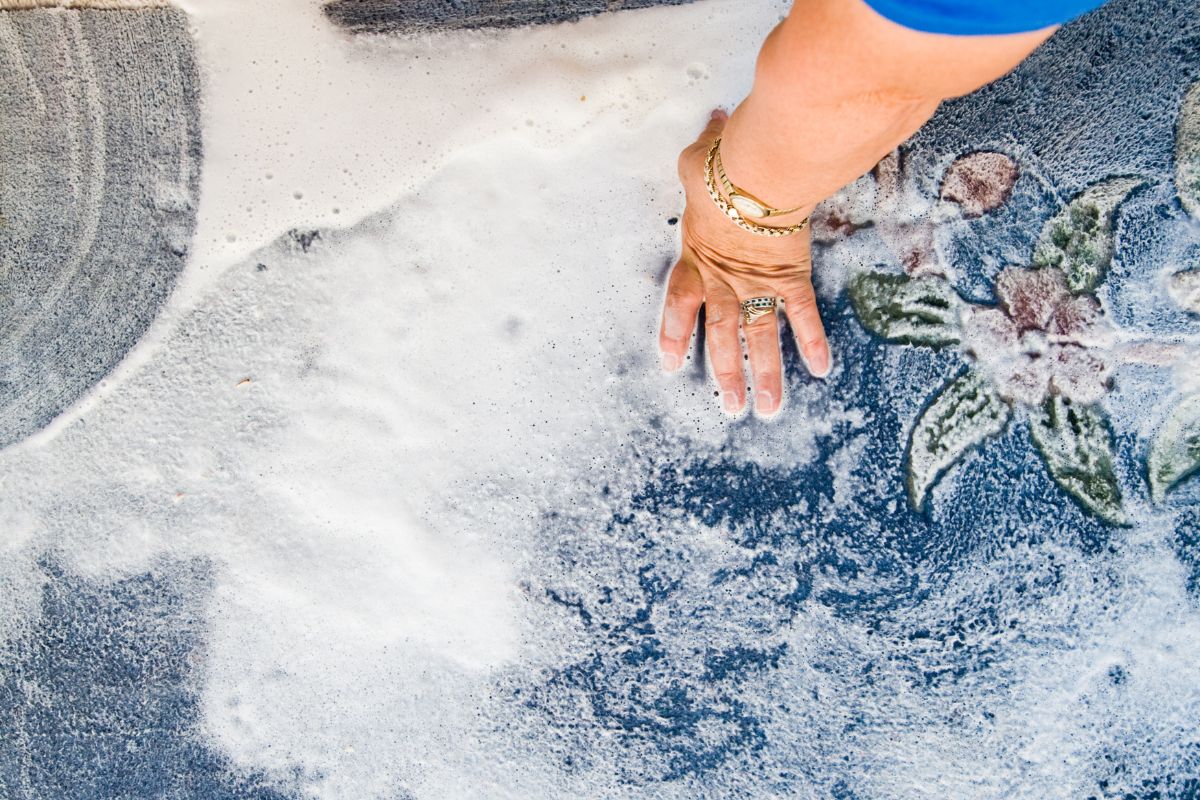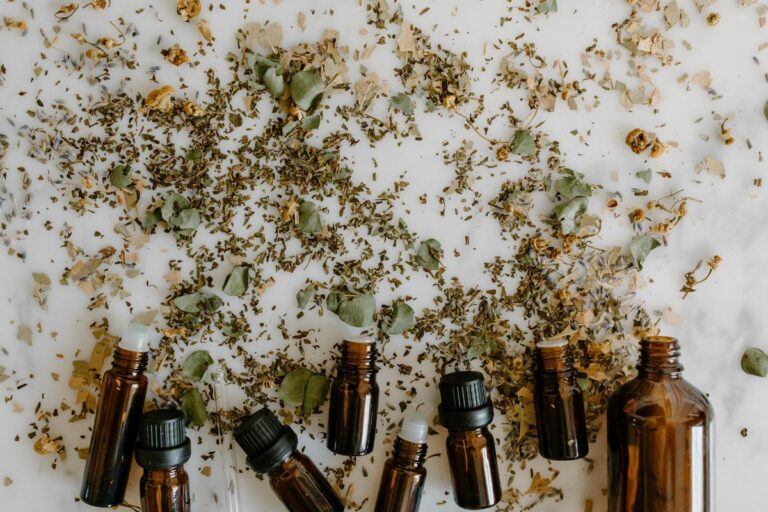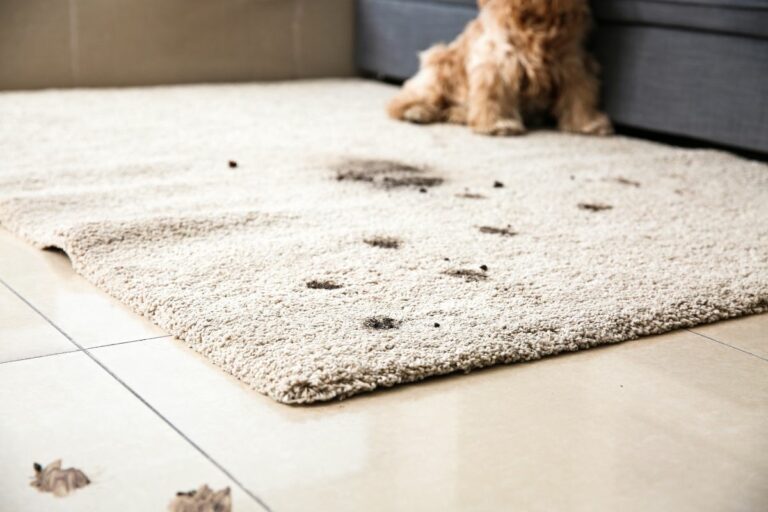Get Rid of Wet Carpet Odor: Expert Tips Worth Reading

Are you tired of that unpleasant wet carpet odor taking over your home? You’re not alone – this common household issue can be embarrassing and frustrating. But fret not! Our expert tips on removing wet carpet smell will help you regain a fresh and odor-free environment.
Get ready to say goodbye to that musty smell! In this blog post, we’ll tackle using baking soda, white vinegar, hydrogen peroxide, and borax to eliminate wet carpet odors effectively.
Read on to discover which method works best for you and restore cleanliness and freshness to your home.
In this article..
- Understanding the Causes of Wet Carpet Odor
- The Power of Baking Soda: An Effective Deodorizer
- White Vinegar: A Natural Odor Neutralizer
- Hydrogen Peroxide: Potent Stain and Odor Remover
- Using Borax for Deep Cleaning Carpets
- Tips for Preventing Wet Carpet Odors
- Choosing the Right Carpet Cleaning Products
- Proper Carpet Maintenance for Long-Term Freshness
Understanding the Causes of Wet Carpet Odor
Understanding the causes of wet carpet odor is essential to solving the problem effectively. Factors such as water spills, mold and mildew growth, pet stains, and liquid odors contribute to the issue. Moisture is the primary reason for the unpleasant smell, as it can trap various scents in the carpet fibers.
If not cleaned properly, water spills can lead to wet carpet odor. To prevent mold and mildew growth, thoroughly dry the carpet immediately.
These fungi thrive in damp environments and produce a musty smell that can be hard to eliminate. Proper ventilation and dehumidifier can help reduce moisture and prevent mold and mildew formation.
Pet stains, such as urine and feces, can also cause wet carpet odor. The organic compounds in these stains can produce foul smells, which get trapped in the carpet fibers.
To address this issue, cleaning the stains thoroughly and using enzyme-based cleaners to effectively break down the odor-causing compounds is crucial.
Using household items like baking soda or vinegar can help eliminate the wet carpet smell. These substances can absorb moisture and neutralize odors in the carpet fibers:
- Baking soda: Sprinkle generously on the affected area, let it sit for a few hours or overnight, then vacuum it up. Baking soda can help remove trapped moisture and neutralize odors.
- Vinegar: Mix equal parts of water and white vinegar in a spray bottle. Lightly mist the affected area and let it air dry. Vinegar is a natural deodorizer and can help disinfect the carpet.
The Power of Baking Soda: An Effective Deodorizer
Baking soda is an effective deodorizer that neutralizes odors instead of just masking them with perfumes. It can be used to remove the wet carpet smell.
Are you annoyed by the smelly odor in your carpet after it gets wet? No worries, baking soda can help! Baking soda can absorb moisture and neutralize the odors on your carpet. Here’s how to remove the damp carpet smell using baking soda:
- Blot up as much moisture as possible using a clean towel or cloth.
- Sprinkle baking soda generously over the wet area of the carpet.
- For more stubborn odors, let the baking soda sit overnight for at least 30 minutes.
- Vacuum the baking soda thoroughly with a vacuum cleaner.
- Repeat the process if necessary until the smell is completely gone.
Baking soda is an effective deodorizer for your carpet and other areas of your home. Here are some more tips on how to use baking soda as a natural odor eliminator:
- Place an open box of baking soda on one of the shelves to remove the refrigerator smell.
- To remove shoe odor, sprinkle baking soda inside the shoes and let sit overnight.
- To remove pet odor, sprinkle baking soda over pet beds and let sit before vacuuming.
Baking soda is a natural, affordable, and safe alternative to chemical-heavy deodorizers. Give it a try and say goodbye to pesky odors in your home!
White Vinegar: A Natural Odor Neutralizer
White vinegar is the solution to remove the wet carpet smell. This natural odor neutralizer contains acetic acid molecules that bond with unpleasant odors.
Fill a dish with half an inch of white vinegar and place it in the room to eliminate musty smells from carpets, rugs, and upholstery. It’s a mild disinfectant that is effective and affordable.
White vinegar is versatile and can be used for various cleaning purposes. Here are some ways to use it:
- Mix equal parts of water and white vinegar to create a solution for cleaning floors, countertops, and bathrooms.
- Combine one part white vinegar with three parts water to spray on weeds and avoid using harsh chemicals.
- Clean your dishwasher by pouring white vinegar into the detergent dispenser and running a cycle.
- Soak a cloth in white vinegar and use it to wipe down the inside of your fridge to eliminate food smells.
Using white vinegar is an eco-friendly and non-toxic way to keep your home smelling fresh and clean. It’s safe to use around children and pets and won’t harm the environment.
Hydrogen Peroxide: Potent Stain and Odor Remover
Hydrogen peroxide shines as a rich stain and odor remover. This powerful solution breaks down bacteria-causing odors, brightens surfaces, and tackles stains without damaging fabrics.
Unlike chlorine bleach, hydrogen peroxide is non-toxic, surface-safe, and keeps your clothes in top condition.
Make your laundry routine eco-friendly by using hydrogen peroxide to:
- Whiten whites: Hydrogen peroxide works wonders on your white clothes, leaving them fresh and clean.
- Brighten colors: Colored fabrics also benefit from this beautiful solution, showing off their vibrant shades.
- Remove odors: Say goodbye to unpleasant smells as hydrogen peroxide eliminates odors from your clothes.
- Sanitize washer: Keep your washing machine tip-top shape by using hydrogen peroxide as a sanitizing alternative to harsh chlorine.
Have you got a smelly situation on your hands? Hydrogen peroxide can combat natural odors from fish, rotten food, and more, making it an essential household helper. Create a DIY pet stain and odor remover by mixing 3% hydrogen peroxide (Oxygen Plus) with liquid dish soap.
This mixture is more effective than enzyme cleaners for tackling urine stains and odors, leaving your home fresher than ever.
Using Borax for Deep Cleaning Carpets
Borax is an effective cleaning agent for deep cleaning carpets. To use borax, mix 1/4 cup salt, 1/4 cup borax, and 1/4 cup vinegar to make a paste. Apply the paste to deep stains or heavily soiled sections of the carpet and allow it to sit for several hours until it dries completely.
Then vacuum it away. Borax can also clean up spills by blotting as much liquid as possible, misting the carpet with cold water, sprinkling some borax on the fall, covering it with a damp rag, and leaving it overnight before vacuuming.
For persistent stains, mix ¼ cup of table salt, ¼ cup of borax, and ¼ cup of white vinegar and apply this mixture to the stained area.
In addition to deep cleaning carpets, borax can also help eliminate unpleasant wet carpet smells. Here are some ways to use borax for this purpose:
Sprinkle borax on the carpet
Sprinkle borax on the affected carpet areas, paying particular attention to the areas with the most smell. Let the borax sit for an hour, and then vacuum it up.
Borax and baking soda mixture
Mix 1 cup of borax and 1 cup of baking soda, and then sprinkle the mixture onto the affected areas of the carpet. Let it sit for an hour, and then vacuum it up.
Borax and essential oils
Mix 1/2 cup of borax with ten drops of your favorite essential oil. Sprinkle this mixture on the carpet and let it sit for an hour before vacuuming it.
Keeping your carpets clean is essential for their appearance and your family’s health. Borax is an inexpensive, non-toxic way to clean carpets and eliminate unpleasant odors. However, it’s crucial to read and follow all instructions carefully and avoid using too much borax, which can cause skin irritation.
Tips for Preventing Wet Carpet Odors
Preventing wet carpet odors starts with keeping the carpet dry and reducing humidity. Use a dehumidifier or air conditioner to maintain a comfortable environment and avoid mold and mildew growth that causes unpleasant smells. Additionally, improve ventilation by keeping a fan running and windows open.
To effectively eliminate odors, utilize household items such as baking soda, vinegar, or Borax. Like many commercial deodorizers, these natural alternatives can absorb moisture and neutralize smells without just masking them temporarily. Follow these steps for the best results:
- Sprinkle baking soda on the affected carpet or rug: Apply a generous amount of baking soda on the wet or musty-smelling area. Baking soda effectively absorbs moisture and neutralizes unwanted smells.
- Let the baking soda sit overnight or up to 48 hours: This allows it to work its magic by absorbing the moisture and neutralizing the odors thoroughly. The longer it sits, the more effective it will be.
- Vacuum the area thoroughly: Once the baking soda has done its job, use a vacuum cleaner to remove the powder from the carpet or rug. This step will leave your carpet smelling fresh and clean.
If the smell persists despite using these techniques, consider professional help. Carpet cleaning services can provide deeper cleaning and odor elimination, especially in persistent mold and mildew problems.
Choosing the Right Carpet Cleaning Products
Choosing the right carpet cleaning products is crucial for maintaining your carpets’ appearance and hygiene. Consider factors like price, weight, and effectiveness before buying. Understand the difference between steam cleaners and carpet shampooers, and decide whether to rent or buy.
First, you should compare carpet cleaning solutions. A good solution is essential to remove dirt effectively and keep your carpets looking great. Here are a few tips for choosing one:
- Look for solutions specifically designed for your carpet type and material.
- Read product reviews and ratings to find the best quality and value.
- Make sure the solution is compatible with your carpet cleaning machine.
Next, consider the weight and size of the carpet cleaner, especially if you have large areas or hard-to-reach spots to clean. Here are some factors to consider:
- Lighter machines are easier to maneuver, reducing physical strain while cleaning.
- Look for machines with smaller tanks if storage space is limited.
- Adding water and cleaning solution will increase the machine’s weight.
Lastly, determine whether renting or buying a carpet cleaner suits your needs and budget. Here are a few points to consider:
- Renting is cost-effective for occasional deep cleaning.
- Owning a machine is more convenient for regular maintenance and spot cleaning.
- Investment in a high-quality cleaner can save money in the long run by reducing professional cleaning expenses.
Proper Carpet Maintenance for Long-Term Freshness
Proper carpet maintenance ensures long-term freshness in your home. It’s vital that you:
- Vacuum regularly: This removes dirt and keeps the fibers looking new. Set the vacuum at the right height to avoid damaging the carpet.
- Use mats: Place them inside and outside your entrances to help collect dirt before it reaches your carpets.
- Leave dirt and shoes at the door: Encourage your household to remove them before entering the living area, reducing the amount of soil tracked through the house.
Additionally, several household items can keep your carpets fresh and clean:
- Cornmeal, Borax, and Baking Soda: These natural ingredients can be sprinkled on carpets to absorb odors and dirt. After letting them sit for an hour, vacuum them up to remove debris and leave your carpet smelling fresh.
- Hydrogen Peroxide, Vinegar, and Rubbing Alcohol: Mix equal parts of these liquids with water to create a stain-fighting solution. Blot spills immediately with a clean cloth, then apply the key for spot cleaning.
- Rosemary and Cinnamon: These aromatic herbs can be added to your carpet cleaning products to provide a delightful scent that keeps your home smelling fresh.
Incorporating these simple tasks and items into your carpet cleaning routine will ensure long-lasting freshness and keep your carpets looking their best.









